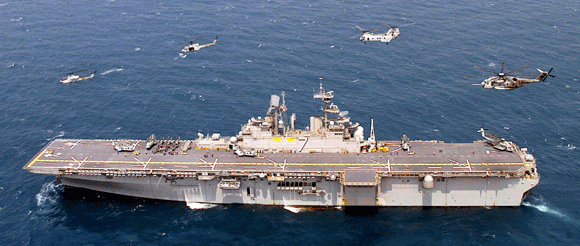The US military has a requirement for new command ships to control joint operations in expeditionary environments. The Navy operates three old amphibious ships that were converted to a command role, but are not fully equipped to support modern forces and are manned only to support Navy operations. Since recent wars occurred near modern US military bases, the need for a command ship has not been recognized. In addition, large fixed headquarters are obvious targets. For example, should the U.S. military attack Iran, the CENTCOM headquarters in Qatar is a prime target for Iranian missile and commando attacks, and could be rendered ineffective for a period of time. In a nuclear war, any large fixed headquarters will be a primary target for total destruction.
While the US Navy recognizes the value of mobile command ships, it has little interest in funding and manning new command ships to support the other armed services. The solution is for the Department of Defense to fund procurement and operational expenses for two new modern command ships outside the Navy's budget, as it does for several other joint programs. Costs can be minimized by procuring the Navy's proven LHD amphibious ship for this role. (below) Half of the hangar deck can be modified into a spacious Combined Air Operations Center (CAOC). Part of the flight deck can be reserved for satellite dishes. The ship will need more quarters for flag officers, and since officers will almost outnumber enlisted, the size of "officer country" will be much larger.

Manning requirements can be minimized by utilizing current joint staffs. For example, the Pacific Command in Hawaii will find it difficult to control a major operation hundreds of miles from Hawaii. Therefore, basing a LHD command ship at Pearl Harbor is ideal, where many headquarters staff personnel assigned to the big headquarters at Camp Smith can also be assigned to the ship. They will often deploy aboard ship for a few weeks to train in support of a major joint exercise in the Pacific.
Ship manning can be split among each armed service to share the burden. While the Navy operates the ship, the Marine Corps can operate an organic helicopter squadron. The Air Force can man and operate all the headquarters command, control, and communications systems, including the CAOC. The Army can provide the ships' medical staff and mess personnel. The Special Operations Command will want space to support its activities. Since the LHD is designed to carry 2000 Marines and 40 helicopters, it has ample space for everyone and everything a large joint headquarters desires, including the equipment and personnel required to establish a large expeditionary joint headquarters ashore.
This ship will solve one of the greatest headaches for expeditionary forces -- supporting the hundreds of higher headquarters officers who show up and demand vehicles, helicopters, housing, messing, and communications support from overburdened combat units. An LHD command ship will have all that support aboard ship. It will also have everything it needs to set up a large command post inland. This can be flown in with the ship's organic helicopters, or landed by the ship's landing craft along with vehicles and tents.
Combat units will be amazed that a major headquarters can support itself, and provide them with emergency support. LHDs have spaces that can be loaded with rations and ammunition to assist operational units ashore. This includes a 600-bed hospital, ample fresh water, and hot chow. In addition, should the US military need to launch a major amphibious operation, these command LHDs can carry some amphibious forces.
The Navy will soon retire its 38-year old command ships with no replacements funded, and the US military will lose key components for future amphibious and expeditionary operations. As a result, the US military will find it very difficult to control a major operation in many areas of the world, as the British encountered during their 1982 war in the Falklands. In addition, US military operations will become chaotic if a major land-based headquarters is destroyed during a war. Modern LHD command ships are the answer.
Carlton Meyer editorG2mil@Gmail.com
©2008 www.G2mil.com